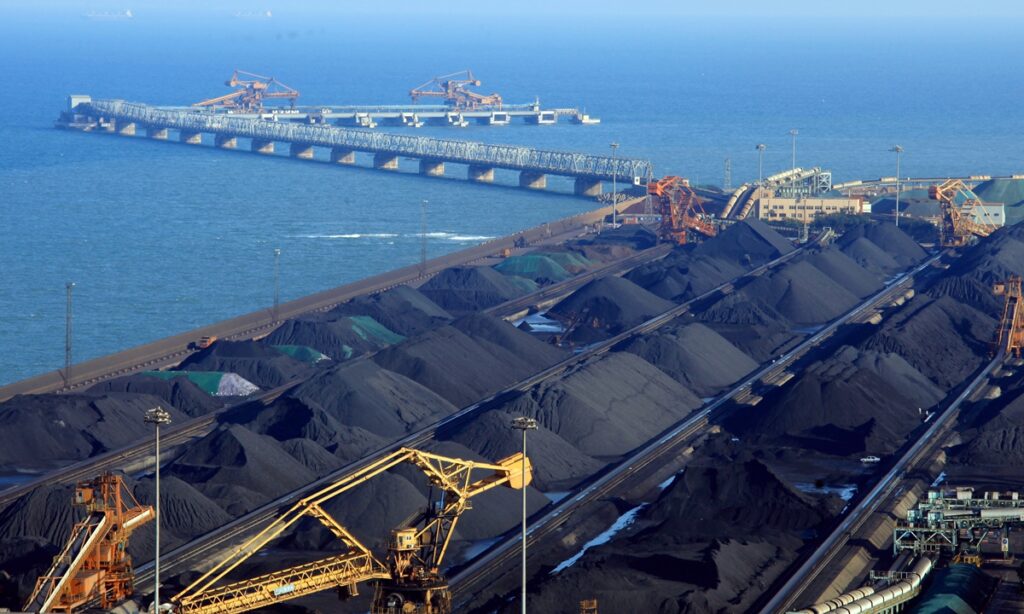Four leading coal producers have openly pledged to strictly observe a price ceiling for thermal coal and ensure coal supplies, as China goes full throttle to ensure supplies before winter heating starts in mid-November and at the same time launches a campaign to put the brakes on runaway coal prices.
State-owned CHN Energy, which accounts for 40 percent of coal supplies for coal ports around the Bohai Bay, announced on Thursday that it has decided to cap the price of 5,500 kilocalorie thermal coal at 1,800 yuan ($281.33) per ton, a move it describes as a “fast response regardless of costs” and aimed at bringing coal prices back to “rational levels.”
Three other companies, State-owned China National Coal Group Corporation, State-owned Jinneng Holding Group, and private-owned Inner Mongolia Yitai Group Co, have made the same pledges, saying that thermal coal will not be sold at over 2,000 yuan per ton.
The ports around the Bohai Bay are transportation hubs from where coal produced in mines of North China are loaded onto ships bound for southern ports, where the coal will be further transported or consumed at power plants. As a result of the announcement from the four companies, coal futures on Thursday plunged to the daily limit, temporarily ending a record-setting trend this week.
The companies made the pledges as China has launched a national campaign to curb skyrocketing coal prices and ensure coal supplies as winter approaches with a wide range of policies this week, in what analysts said reflected China’s national and system advantage.
National Development and Reform Commission (NDRC) said on Thursday that it is conducting a comprehensive investigation on the production and circulation process of coal as the basis for its recently announced “specific intervention measures to be taken on coal prices” based on the country’s price law. The economic planning body said rapidly increasing prices for coal push up costs for downstream companies and have negative impacts for power supply and winter heating.
Li Chaolin, a veteran coal industry analyst, told the Global Times on Thursday that one of the reasons for the runaway coal prices is that while China has enough coal production capacity, actual output still cannot meet demand as the winter heating season approaches.
After a period of centralizing efforts, State-owned coal producers now control much of the country’s coal production and their pledges of being “willing to give up some profits for the common good and ensure a warm winter for the people” will likely produce an impact within a short time.
Wang Yongzhong, head of the Institute of World Economics and Politics under the Chinese Academy of Social Sciences, told the Global Times on Thursday that the four enterprises are leaders in the industry, and “their voices stand for specific acts from the country’s administration level, which will effectively curb surging coal prices.”
Chinese Premier Li Keqiang reiterated at Wednesday’s State Council executive meeting the importance of ensuring people’s winter heating, vowed to continue efforts to crack down on coal price speculation and cautioned against allowing rising prices for commodities to be passed downstream and hurting small- and micro-sized enterprises.
After the country’s power plants complained that their profits were being cut due to rising coal prices and capped electricity prices, China relaxed restrictions on the country’s coal-fired power pricing mechanism to 20 percent in a bid to ease the operating difficulties faced by coal-fired power generation enterprises.
An industry insider at a power plant saw the pledges by leading coal producers on Thursday as positive news, believing a cap in thermal coal prices will help national efforts to ensure winter heating and electricity generation.
Effective response
Analysts said the fast response came from China’s national and system advantages, and with the Chinese central government’s ability to tackle issues by mobilizing all national resources in a short time.
“The country’s series and combo adjustment measures are both necessary and effective, even though the timing is a little bit late,” Han Xiaoping, chief analyst at energy industry website china5e.com, told the Global Times on Thursday.
Han believed that the adjustments were conducted from the level of government and related authorities, and they can restrict the current surging prices of coal used for power generation.
The NDRC said on Tuesday that said it would ensure coal mines operate at full capacity and will achieve at least 12 million tons per day of output, which would be up more than 1.6 million tons from late September.
Safe and normal production of coal will not be interrupted by holidays and major events, and the practice of shutting down coal mines or suspending production in an entire region due to individual coal mine accidents has been prohibited.
This lift in daily coal production amounts to coal production of 4.3 billion tons a year, will push down coal prices and help the country go through the winter smoothly, said Han.
In comparison, total coal output at China’s coal mines was 3.9 billion tons in 2020. In recent years, China has been phasing out outdated coal production capacity by 1 billion tons per year and closed 5,500 coal mines.
Diversified supply
In addition to boosting domestic supply, China has recently increased coal and power supply from neighboring countries including Russia and Mongolia as well as imports of seaborne coal from Indonesia.
Local newspaper Heilongjiang News reported on Thursday that around 600 tons of Russian coal was imported to China by ship via the Jiameng Port in Northeast China’s Heilongjiang Province to ease the current power pinch. The port was reopened after being closed for seven years.
China has also turned to Russian power company InterRAO, the only electricity exporter in Russia to increase electricity supply to neighboring regions. InterRAO doubled electricity supply to China compared to the same period last year, Russian media reported.
From Mongolia, multiple ports including Ganqimaodu Port and Erenhot Port tried to maintain coal supplies despite quarantine measures in place due to a regional COVID-19 outbreak along the border.
China imported over 21 million tons of coking coal, steam coal and lignite from Indonesia in September, up from roughly 17 million tons in August, Bloomberg reported on Thursday, citing customs data.



